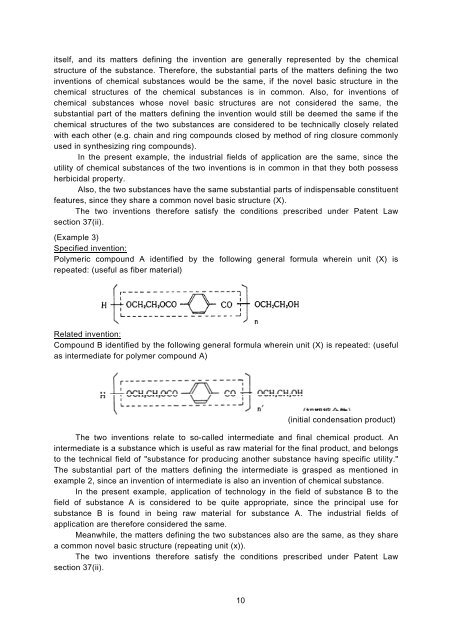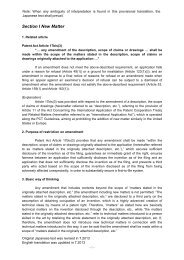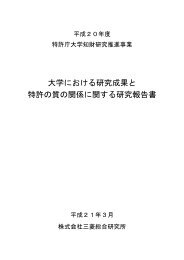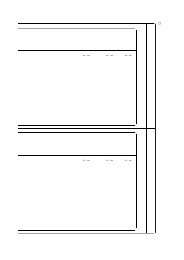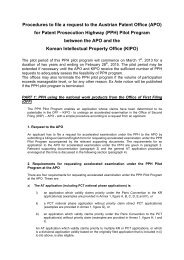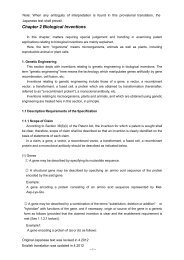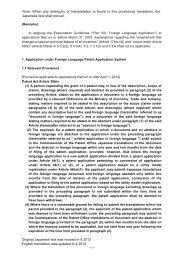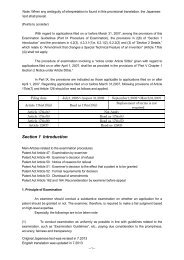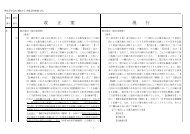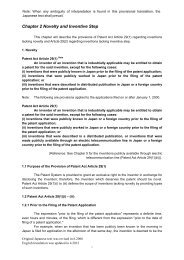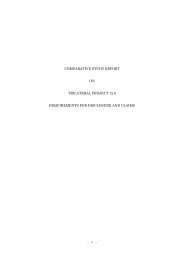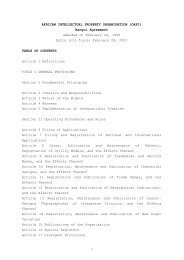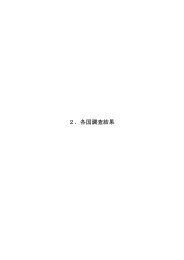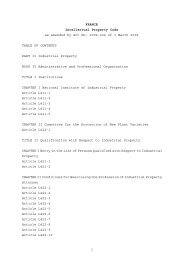Requirements for Unity of Application - Japan Patent Office
Requirements for Unity of Application - Japan Patent Office
Requirements for Unity of Application - Japan Patent Office
You also want an ePaper? Increase the reach of your titles
YUMPU automatically turns print PDFs into web optimized ePapers that Google loves.
itself, and its matters defining the invention are generally represented by the chemical<br />
structure <strong>of</strong> the substance. There<strong>for</strong>e, the substantial parts <strong>of</strong> the matters defining the two<br />
inventions <strong>of</strong> chemical substances would be the same, if the novel basic structure in the<br />
chemical structures <strong>of</strong> the chemical substances is in common. Also, <strong>for</strong> inventions <strong>of</strong><br />
chemical substances whose novel basic structures are not considered the same, the<br />
substantial part <strong>of</strong> the matters defining the invention would still be deemed the same if the<br />
chemical structures <strong>of</strong> the two substances are considered to be technically closely related<br />
with each other (e.g. chain and ring compounds closed by method <strong>of</strong> ring closure commonly<br />
used in synthesizing ring compounds).<br />
In the present example, the industrial fields <strong>of</strong> application are the same, since the<br />
utility <strong>of</strong> chemical substances <strong>of</strong> the two inventions is in common in that they both possess<br />
herbicidal property.<br />
Also, the two substances have the same substantial parts <strong>of</strong> indispensable constituent<br />
features, since they share a common novel basic structure (X).<br />
The two inventions there<strong>for</strong>e satisfy the conditions prescribed under <strong>Patent</strong> Law<br />
section 37(ii).<br />
(Example 3)<br />
Specified invention:<br />
Polymeric compound A identified by the following general <strong>for</strong>mula wherein unit (X) is<br />
repeated: (useful as fiber material)<br />
Related invention:<br />
Compound B identified by the following general <strong>for</strong>mula wherein unit (X) is repeated: (useful<br />
as intermediate <strong>for</strong> polymer compound A)<br />
(initial condensation product)<br />
The two inventions relate to so-called intermediate and final chemical product. An<br />
intermediate is a substance which is useful as raw material <strong>for</strong> the final product, and belongs<br />
to the technical field <strong>of</strong> "substance <strong>for</strong> producing another substance having specific utility."<br />
The substantial part <strong>of</strong> the matters defining the intermediate is grasped as mentioned in<br />
example 2, since an invention <strong>of</strong> intermediate is also an invention <strong>of</strong> chemical substance.<br />
In the present example, application <strong>of</strong> technology in the field <strong>of</strong> substance B to the<br />
field <strong>of</strong> substance A is considered to be quite appropriate, since the principal use <strong>for</strong><br />
substance B is found in being raw material <strong>for</strong> substance A. The industrial fields <strong>of</strong><br />
application are there<strong>for</strong>e considered the same.<br />
Meanwhile, the matters defining the two substances also are the same, as they share<br />
a common novel basic structure (repeating unit (x)).<br />
The two inventions there<strong>for</strong>e satisfy the conditions prescribed under <strong>Patent</strong> Law<br />
section 37(ii).<br />
10


